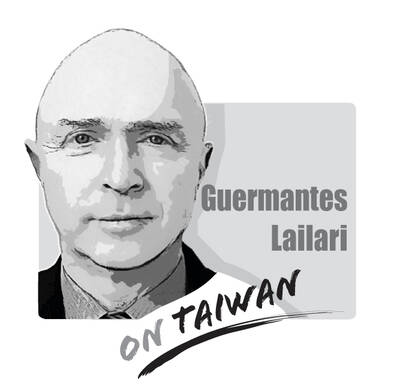A photograph of former president Ma Ying-jeou (馬英九) taking a deep bow before a statue of Sun Yat-sen (孫逸仙) while presenting a yellow floral wreath at the Republic of China founder’s mausoleum in Nanjing during his 12-day visit to China from March 27 to April 7 was used in a propaganda video released on Thursday by the Chinese People’s Liberation Army’s Eastern Theater Command.
The video titled China, We Cannot Lose Even One Inch of It (中國,一點都不能少) showed photos from the second Sino-Japanese War and the surrender of Japanese forces in China, as well as Ma’s visit in Nanjing and a large billboard in Xiamen, China, bearing the slogan “one country, two systems, unite China.”
Captions in the video said that “Chinese soldiers stand firm in protecting the blood and family that cannot be lost” as a map of Taiwan was displayed, implying that people in Taiwan and China have “the same roots,” while the narrator reads a poem about “uniting against a foreign enemy.”
The video was released shortly after China ended its three-day military exercises around Taiwan following a meeting between President Tsai Ing-wen (蔡英文) and US House of Representatives Speaker Kevin McCarthy in Los Angeles the week before and on the same day that Beijing announced an investigation of Taiwan’s trade barriers on more than 2,400 Chinese products.
The timing of the video’s release and controversial remarks by Ma during his time in China have prompted criticism of the former president and his Chinese Nationalist Party (KMT), including accusations that he was a tool for the Chinese Communist Party’s (CCP) “united front” tactics and advocated Beijing’s “one China” principle.
Earlier this week, parents of students at Taipei Municipal Dunhua Elementary School were shocked to learn that a clip of the school’s choir singing a song conveying nostalgia for China had been screened in a Lunar New Year special aired by a Chinese state TV channel.
The choir were asked to perform We Sing the Same Song (我們同唱一首歌), which the Mainland Affairs Council has labeled a Chinese “united front” propaganda song. Three Taiwanese sang it in China Central Television’s Lunar New Year show last year, and China’s Taiwan Affairs Office has said the song “expresses Taiwanese people’s nostalgia and recognition to ancestors, and the blood-is-thicker-than-water kinship of people on both sides of the Strait.”
The video of the choir sparked an outcry, with people asking why children were used for Chinese “united front” propaganda. The school said that it had merely arranged a cultural exchange and the video had been edited.
While Ma and the school said their intentions were to promote cultural exchanges, the two videos highlight that for the CCP, everything is part of its plan to infiltrate all sectors of Taiwanese society.
Leaving aside the possibility that Ma and the KMT are working with the CCP to some extent, local governments, schools and the public must raise their awareness about China’s “united front” tactics.
Chinese-language news reports in 2019 said that more than 3,000 Taiwanese students visited China each summer on Chinese government-funded camps, tours and forums touted as “cultural and academic exchanges.” As COVID-19 restrictions were eased and national borders reopened, the tactics resumed, such as when dozens of Kaohsiung borough wardens were invited to China in February.
Academics have warned that “united front” and cognitive warfare campaigns are expected to increase ahead of next year’s presidential and legislative elections. If people lack the political literacy and awareness to recognize them, they might become the unwitting tools of propagandists.

Chinese state-owned companies COSCO Shipping Corporation and China Merchants have a 30 percent stake in Kaohsiung Port’s Kao Ming Container Terminal (Terminal No. 6) and COSCO leases Berths 65 and 66. It is extremely dangerous to allow Chinese companies or state-owned companies to operate critical infrastructure. Deterrence theorists are familiar with the concepts of deterrence “by punishment” and “by denial.” Deterrence by punishment threatens an aggressor with prohibitive costs (like retaliation or sanctions) that outweigh the benefits of their action, while deterrence by denial aims to make an attack so difficult that it becomes pointless. Elbridge Colby, currently serving as the Under
The Ministry of the Interior on Thursday last week said it ordered Internet service providers to block access to Chinese social media platform Xiaohongshu (小紅書, also known as RedNote in English) for a year, citing security risks and more than 1,700 alleged fraud cases on the platform since last year. The order took effect immediately, abruptly affecting more than 3 million users in Taiwan, and sparked discussions among politicians, online influencers and the public. The platform is often described as China’s version of Instagram or Pinterest, combining visual social media with e-commerce, and its users are predominantly young urban women,
Most Hong Kongers ignored the elections for its Legislative Council (LegCo) in 2021 and did so once again on Sunday. Unlike in 2021, moderate democrats who pledged their allegiance to Beijing were absent from the ballots this year. The electoral system overhaul is apparent revenge by Beijing for the democracy movement. On Sunday, the Hong Kong “patriots-only” election of the LegCo had a record-low turnout in the five geographical constituencies, with only 1.3 million people casting their ballots on the only seats that most Hong Kongers are eligible to vote for. Blank and invalid votes were up 50 percent from the previous
Japanese Prime Minister Sanae Takaichi lit a fuse the moment she declared that trouble for Taiwan means trouble for Japan. Beijing roared, Tokyo braced and like a plot twist nobody expected that early in the story, US President Donald Trump suddenly picked up the phone to talk to her. For a man who normally prefers to keep Asia guessing, the move itself was striking. What followed was even more intriguing. No one outside the room knows the exact phrasing, the tone or the diplomatic eyebrow raises exchanged, but the broad takeaway circulating among people familiar with the call was this: Trump did